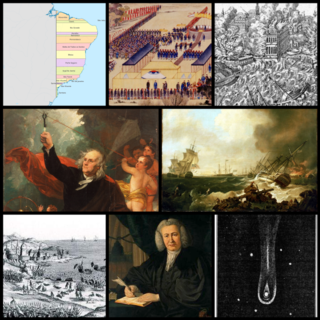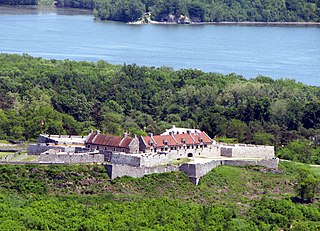
The 1750s was a decade of the Gregorian calendar that began on January 1, 1750, and ended on December 31, 1759. The 1750s was a pioneering decade. Waves of settlers flooded the New World in hopes of re-establishing life away from European control, and electricity was a field of novelty that had yet to be merged with the studies of chemistry and engineering. Numerous discoveries of the 1750s forged the basis for contemporary scientific consensus. The decade saw the end of the Baroque period.

1759 (MDCCLIX) was a common year starting on Monday of the Gregorian calendar and a common year starting on Friday of the Julian calendar, the 1759th year of the Common Era (CE) and Anno Domini (AD) designations, the 759th year of the 2nd millennium, the 59th year of the 18th century, and the 10th and last year of the 1750s decade. As of the start of 1759, the Gregorian calendar was 11 days ahead of the Julian calendar, which remained in localized use until 1923.

The French and Indian War (1754–1763) was a theater of the Seven Years' War, which pitted the North American colonies of the British Empire against those of the French, each side being supported by various Native American tribes. At the start of the war, the French colonies had a population of roughly 60,000 settlers, compared with 2 million in the British colonies. The outnumbered French particularly depended on their native allies.

Fort Ticonderoga, formerly Fort Carillon, is a large 18th-century star fort built by the French at a narrows near the south end of Lake Champlain, in northern New York, in the United States. It was constructed by Canadian-born French military engineer Michel Chartier de Lotbinière, Marquis de Lotbinière between October 1755 and 1757, during the action in the "North American theater" of the Seven Years' War, often referred to in the US as the French and Indian War. The fort was of strategic importance during the 18th-century colonial conflicts between Great Britain and France, and again played an important role during the Revolutionary War.

Louis-Joseph de Montcalm-Gozon, Marquis de Montcalm de Saint-Veran was a French soldier best known as the commander of the forces in North America during the Seven Years' War.

George Augustus Howe, 3rd Viscount Howe was a career officer and a brigadier general in the British Army. He was described by James Wolfe as "the best officer in the British Army". He was killed in the French and Indian War in a skirmish at Fort Ticonderoga the day before the Battle of Carillon, an ultimately disastrous attempt by the British to capture French-controlled Fort Carillon.

This section of the Timeline of Quebec history concerns the events relating to the Quebec portion of New France between the establishment of the Sovereign Council and the fall of Quebec.

The Battle of Ticonderoga of 1759 was a minor confrontation at Fort Carillon on July 26 and 27, 1759, during the French and Indian War. A British military force of more than 11,000 men under the command of General Sir Jeffery Amherst moved artillery to high ground overlooking the fort, which was defended by a garrison of 400 Frenchmen under the command of Brigadier General François-Charles de Bourlamaque.

Events from the year 1758 in Canada.

Events from the year 1759 in Canada.
The New Hampshire Provincial Regiment was a provincial military regiment made up of men from the New Hampshire Militia during the French and Indian War for service with the British Army in North America. It was first formed in 1754 with the start of hostilities with France.
Events from the year 1755 in Great Britain.
Events from the year 1762 in Great Britain.
Events from the year 1757 in Great Britain.
Events from the year 1756 in Great Britain.
Events from the year 1754 in Great Britain.
Events from the year 1758 in Great Britain.
Events from the year 1761 in Great Britain.

Great Britain was one of the major participants in the Seven Years' War, which in fact lasted nine years, between 1754 and 1763. British involvement in the conflict began in 1754 in what became known as the French and Indian War. However the warfare in the European theater involving countries other than Britain and France commenced in 1756. Britain emerged from the war as the world's leading colonial power, having gained all of New France in North America, ending France's role as a colonial power there. Following Spain's entry in the war in alliance with France in the third Family Compact, Britain captured the major Spanish ports of Havana, Cuba and Manila, in the Philippines in 1762, and agreed to return them in exchange for Spanish Florida. The Treaty of Paris in 1763 formally ended the conflict and Britain established itself as the world's pre-eminent naval power.
Events from the year 1759 in France. France is a major participant in the Seven Years' War and its North American theater, the French and Indian War.









